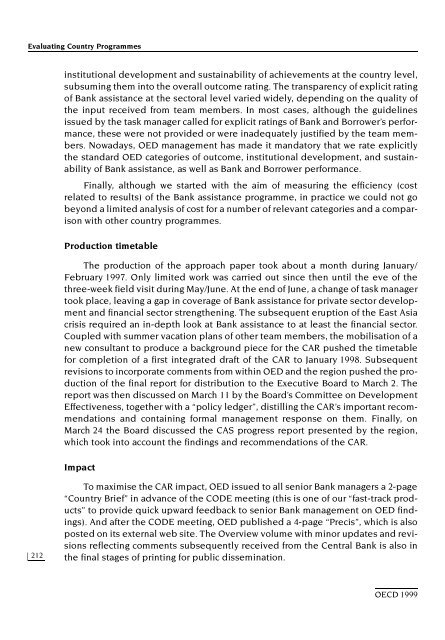Evaluating Country Programmes - OECD Online Bookshop
Evaluating Country Programmes - OECD Online Bookshop
Evaluating Country Programmes - OECD Online Bookshop
Create successful ePaper yourself
Turn your PDF publications into a flip-book with our unique Google optimized e-Paper software.
<strong>Evaluating</strong> <strong>Country</strong> <strong>Programmes</strong><br />
212<br />
institutional development and sustainability of achievements at the country level,<br />
subsuming them into the overall outcome rating. The transparency of explicit rating<br />
of Bank assistance at the sectoral level varied widely, depending on the quality of<br />
the input received from team members. In most cases, although the guidelines<br />
issued by the task manager called for explicit ratings of Bank and Borrower’s performance,<br />
these were not provided or were inadequately justified by the team members.<br />
Nowadays, OED management has made it mandatory that we rate explicitly<br />
the standard OED categories of outcome, institutional development, and sustainability<br />
of Bank assistance, as well as Bank and Borrower performance.<br />
Finally, although we started with the aim of measuring the efficiency (cost<br />
related to results) of the Bank assistance programme, in practice we could not go<br />
beyond a limited analysis of cost for a number of relevant categories and a comparison<br />
with other country programmes.<br />
Production timetable<br />
The production of the approach paper took about a month during January/<br />
February 1997. Only limited work was carried out since then until the eve of the<br />
three-week field visit during May/June. At the end of June, a change of task manager<br />
took place, leaving a gap in coverage of Bank assistance for private sector development<br />
and financial sector strengthening. The subsequent eruption of the East Asia<br />
crisis required an in-depth look at Bank assistance to at least the financial sector.<br />
Coupled with summer vacation plans of other team members, the mobilisation of a<br />
new consultant to produce a background piece for the CAR pushed the timetable<br />
for completion of a first integrated draft of the CAR to January 1998. Subsequent<br />
revisions to incorporate comments from within OED and the region pushed the production<br />
of the final report for distribution to the Executive Board to March 2. The<br />
report was then discussed on March 11 by the Board’s Committee on Development<br />
Effectiveness, together with a “policy ledger”, distilling the CAR’s important recommendations<br />
and containing formal management response on them. Finally, on<br />
March 24 the Board discussed the CAS progress report presented by the region,<br />
which took into account the findings and recommendations of the CAR.<br />
Impact<br />
To maximise the CAR impact, OED issued to all senior Bank managers a 2-page<br />
“<strong>Country</strong> Brief” in advance of the CODE meeting (this is one of our “fast-track products”<br />
to provide quick upward feedback to senior Bank management on OED findings).<br />
And after the CODE meeting, OED published a 4-page “Precis”, which is also<br />
posted on its external web site. The Overview volume with minor updates and revisions<br />
reflecting comments subsequently received from the Central Bank is also in<br />
the final stages of printing for public dissemination.<br />
<strong>OECD</strong> 1999

















![CQE=U]^\]Z: KAZAKHSTAN - OECD Online Bookshop](https://img.yumpu.com/3915768/1/190x253/cqeuz-kazakhstan-oecd-online-bookshop.jpg?quality=85)